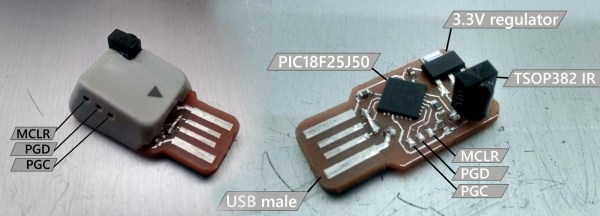Shards of silicon these days, they’re systematically taking what used to be rather complicated and making it dead simple in terms of both hardware and software. Take, for instance, this IR to HID Keyboard module. Plug it into a USB port, point your remote control at it, and you’re sending keyboard commands from across the room.
To do this cheaply and with a small footprint used to be the territory of bit-banging software hacks like V-USB, but recently the low-cost lines of microcontrollers that are anything but low-end have started speaking USB in hardware. It’s a brave new world.
In this case we’re talking about the PIC18F25J50 which is going to ring in at around three bucks in single quantity. The other silicon invited to the party is an IR receiver (which demodulates the 38 kHz carrier signal used by most IR remotes) with a regulator and four passives to round out the circuit. the board is completely single-sided with one jumper (although the IR receiver is through-hole so you don’t quite get out of it without drilling). All of this is squeezed into a space small enough to be covered by a single key cap — a nice touch to finish off the project.
[Suraj] built this as a FLIRC clone — a way to control your home-built HTPC from the sofa. Although we’re still rocking our own HTPC, it hasn’t been used as a front-end for many years. This project caught our attention for a different reason. We want to lay down a challenge for anyone who is attending SuperCon (or not attending and just want to show off their chops).
This is nearly the same chip as you’ll find on the SuperCon badge. That one is a PIC18LF25K50, and the board already has an IR receiver on it. Bring your PIC programmer and port this code from MikroC over to MPLAB X for the sibling that’s on the badge and you’ll get the hacking cred you’ve long deserved.
[via Embedded Lab]













